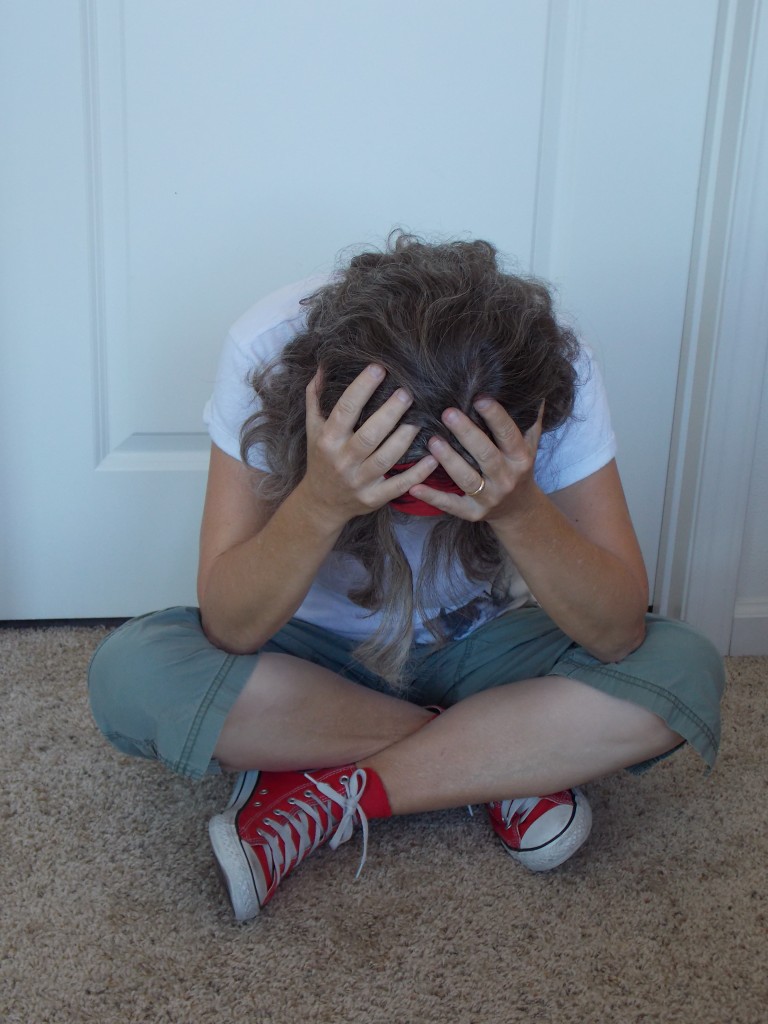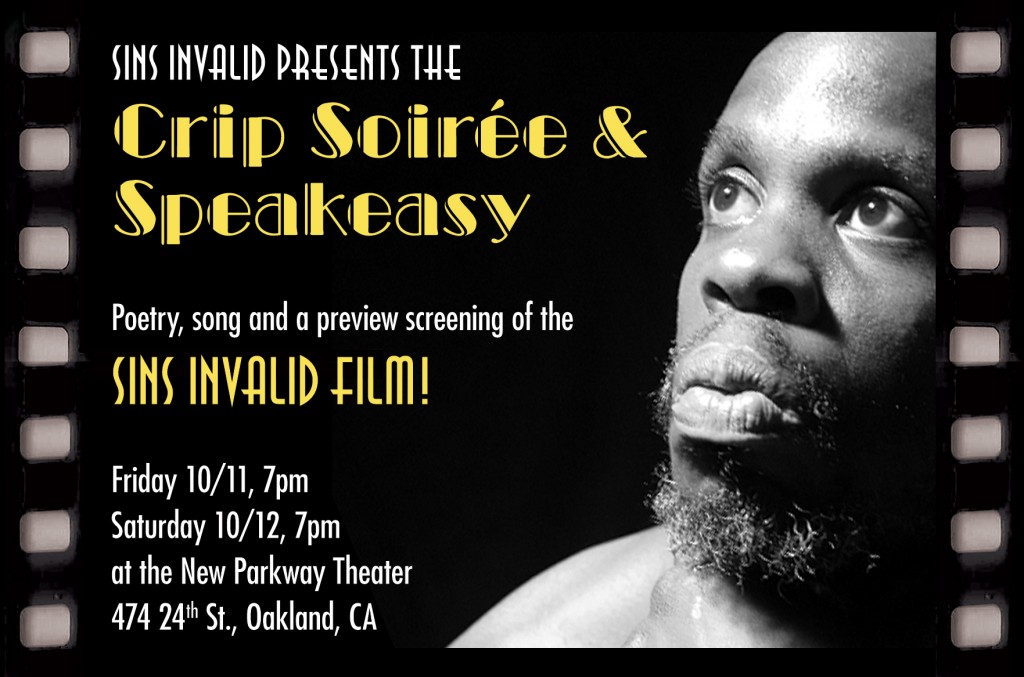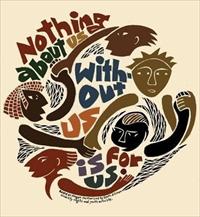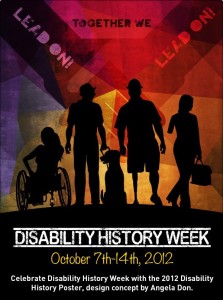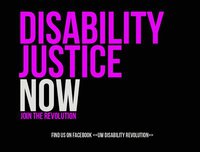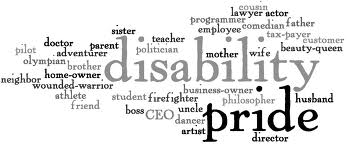A Conversation with My Fellow Travelers
I have begun handing out bag lunches in the park by the river. A great number of homeless people hang out there during the day — some in the meadow, some by the pond, some under the trees. The bag lunches are nothing fancy: a sandwich, some fruit, a dessert. I carry them in my rolling cart, and I walk along with my cane, asking people whether they’d like something to eat.
On Monday, I happened upon three guys sitting on benches — two on one bench and one on the bench across from them. Two of the guys were white and looked to be in their 60s. The other was in his 20s and Hispanic. All were very, very drunk. I walked over and asked if they were hungry and wanted some lunch. They took the lunches, and then one of the older guys said to me, “Sweetheart, we’re just a bunch of drunks. You’re traveling in the wrong circles.”
I said, “I don’t care if you’re drunks. You need something to eat, don’t you?”
At this point, the older man on the other bench called me over and gave me a book of scriptural quotes, kissing it first. The book was one of those little 3 1/2″ x 5″ photo albums into which someone had fit pages with scriptural passages. He showed me the pages. “This one is from Romans,” he said. “And this one is from Palms.” (Not Psalms. Palms. I loved that.)
I thanked him for the gift. As I turned to leave, the first man repeated a version of what he had said before: “Sweetheart, we’re just a bunch of drunks. We have money for food, but we spend it on booze. You’re traveling in the wrong circles, sister.”
Somehow, the repetition just stopped me in my tracks. In a split second, I felt so keenly how many people have been cast out from so many circles. I felt so keenly how many circles I’ve been cast out from over the course of my life. I felt how much I love what I do, because I can move through the park, and be accepted, and give kindness and respect, and receive it in equal measure.
So I just smiled and said, “No, brother. There are no wrong circles.”
And then I went on my way, carrying them with me, knowing they are kin.
© 2013 by Rachel Cohen-Rottenberg
Guest Post: No Apologies
Following is a guest post by my husband, Bob Rottenberg, about his experience of going through airport security with disabilities. Bob uses a knee brace and has some age-related hearing loss, with tinnitus in his right ear. He travels frequently between the coasts.
No Apologies
I’m traveling a lot these days, mostly flying to and from California to spend time with my very frail and very old father in New York City. On the average, I make the round trip once a month. This means going through airport security twice (coming and going) in the span of a week or so.
I’m almost 69, in good physical health overall, but there are two things that slow me down.
One is my hearing, which is still OK, but my right ear isn’t what it used to be, so I’m increasingly affected by background noise. The other is my right knee, which is ready to have some torn cartilage removed. As a result, when I travel I wear a fairly substantial brace on that knee. A brace that always sets off the body scanner alarms.
I’ve become both resigned to and accepting of the pat-down by the TSA screeners – knowing that the only thing they’ll find is a knee brace, which is not a problem for them.
Because I know that I have to go through this process, I try very hard to get to the airport with plenty of time to spare. This allows me to be as relaxed as possible in a very stressful environment. And it allows me to cooperate with the screeners, and let them know what’s going on for me.
Today, because the New York airport didn’t have the latest screening technology, I had to undergo a “full-body” pat-down. The agent started explaining what he was going to do, asking if I understood and assented. The problem was, even though I knew what he was going to do, I couldn’t really understand what he was saying, and didn’t want to simply nod in agreement. Part of it was my hearing, which is always compromised in a noisy environment. The other was the agent’s speech, which was both unclear, due to his accent, and coming at me at a very rapid pace. So I kept asking him to repeat what he had said, because I literally could not make sense of his words, and I didn’t want to get anything wrong, and risk setting off more alarm bells and having to sit on the Group W bench with the other hardened criminals – and, of course, risk missing my flight home.
At that point, a female agent came along and, perhaps realizing that I wasn’t understanding the first agent’s attempts at the King’s English, repeated everything he had said, but more clearly. The exam proceeded, took all of one minute, and I was cleared for takeoff.
So what did I learn from this? That it’s important for me to not apologize about my “condition;” that’s it’s OK to for me to slow things down, to make sure I understand everything that’s being asked of me, and to then do everything I can to make the job of the agents go more smoothly – all so that my day can proceed more smoothly.
And today, this worked. I refused to apologize for my condition – for my less-than-adequate hearing, and for my knee-in-need-of-surgery – but I was completely willing to let them know what I needed, in as non-confrontational manner as possible. This is who I am right now, and I accept my condition fully. But I also realized that I did not want to make my condition a “problem” for the agents. This is why I insisted on taking the small amount of extra time to make sure I heard and understood what their needs were. I’ve seen too many instances where the lack of clarity leads to unfortunate outcomes.
Not feeling rushed certainly helps me to take full responsibility for myself in these moments. I can imagine how I would feel if, under pressure to make that flight in the next ten minutes, I had to do combat with agents whose words I could not clearly understand. I take the approach that they are there to help me get to my destination safely. And my responsibility to them is to be as clear as I can about my own needs, so that we can both get on with our day in as pleasant a way as possible.
And this is what I learned: Just as they shouldn’t have to apologize for simply doing their jobs, I shouldn’t have to apologize for being who I am.
© 2013 by Rachel Cohen-Rottenberg
Why So Many Fail to Understand Systemic Oppression
I was recently in a discussion about the ways in which people of color are disproportionately targeted by the police (think: stop-and-frisk, among other rights violations), disproportionately incarcerated, and disproportionately imprisoned for long stretches. As is often the case in these kinds of discussions, someone came blundering in with a “solution” — the “solution” being that people of color just need to be compliant with police officers and not do anything at all that could possibly be construed as suspicious or alarming. In other words, people of color simply had to act “normal” and all would be well.
I kept reading those words over and over, because I found them so shocking. It wasn’t just that the ideas were wrong — that they evinced an ignorance of racism and an idealized sense of control. It’s that they were based on an outlook that I once believed was grounded in fact: that society is “just” and that all I had to do to be safe was to do everything “right.”
That was a lifetime ago. At some point, I realized that there was no way to do it “right” because, in the eyes of the society in which I live, I am already seen as “wrong.” This assumption of wrongness is why marginalized people get the attention of the police, not to mention other authority figures, for driving while black, for walking while trans, for standing while disabled. We’re already considered “wrong” in the first place.
Some people’s bodies are themselves considered provoking. Not our intentions. Not our attitudes. Not our actions. OUR BODIES. To understand this very basic fact goes against the whole notion that the society one lives in is just — that the good are rewarded and that the guilty are punished. It’s deeply terrifying to realize how truly irrational people are when it comes to the arbitrary meanings they place on human bodies. It means that entire systems are based on completely arbitrary and irrational standards. It goes against the whole Western notion that humans are rational and enlightened beings.
It’s a very hard thing to wrap your mind around until it comes your way. And even when it does come your way, it’s still something that is difficult to face. This is one of the reasons that even people inside marginalized groups can fail to grasp the systemic injustices directed against their bodies. Or if they do grasp it, they can fail to understand the irrationality of the hatred directed toward other people’s bodies. So you find gay and lesbian people who are racist and transphobic, and you find people of color who are homophobic and ableist, and you find transgender people who are ageist and fatphobic, and you find disabled people who are misogynist and classist. Depending on who you talk to, you’ll find a multitude of permutations of all of these bigotries, including the horrifying specter of internalized hatred against one’s own body.
To realize that these valuations are simply arbitrary — that there is no good reason at all to suspect a body just for being a body — means to recognize that we are all at risk. Stigma is a moveable feast. It is mercilessly easy to move from a privileged category to a stigmatized category. Just ask anyone who has ever been diagnosed with a disability after living with the privileges of able-bodiedness, or anyone who has ever become fat after being thin, or anyone who has become old after a lifetime of looking youthful. The whole notion that the society is constructed along rational lines comes crashing down. And then you have to reconstruct your sense of how it works, piece by piece.
You’ll find other people who have woken up and found a new way of seeing. But you’ll never really believe again that the world you live in is just.
© 2013 by Rachel Cohen-Rottenberg
Displays of Power
I went down to the Santa Cruz Wharf today and spent some time people-watching. I am often observing people. I am always fascinated by the ways in which they interact with one another. Today, two scenarios caught my eye:
Scenario 1: When I came onto the wharf, a bicyclist was riding up to the toll booth, getting ready to exit. He was a young man of about 25. As soon as he got to the toll booth, the automatic gate arm came down and blocked his path. He stopped short and fell off his bicycle. To my left, I heard someone laugh. I looked over and saw a young man laughing and pointing at the guy who was struggling to get up. The bicyclist finally got on his bike and rode away.
Scenario 2: At the end of the wharf, a young girl of about five was chasing pigeons. She ran around, looking for pigeons, everywhere she could. She took great glee in shaking her paper bag at them and frightening them so that they flew away. She showed no signs of tiring of the game.
What these two scenarios have in common is someone taking power over a creature in a weaker position. One person took power by laughing at someone who had fallen. The other — a small, vulnerable creature herself — took power over creatures even smaller and more vulnerable.
I try to stay away from questions of what human beings are “really” like, because I’m not sure you can separate the power relationships in a society from what human beings are “really” about. In our society, at any rate, it seems that people are trained up to take power over someone they perceive as vulnerable.
I think this is why so many people have such a deep and abiding fear of becoming disabled. I don’t think it has as much to do with disability in the body as with perceived vulnerability. What happens to me if I’m dependent on others? Will I really be able to depend on them? Or will they take advantage of my vulnerability?
There are very fine people who don’t take advantage of vulnerability. These are the folks who want to raise people up in dignity rather than lord power over them. I try to find those people and hold them very close. Because the other kind will wreak havoc with your life.
© 2013 by Rachel Cohen-Rottenberg
I Am Now Officially a Bitter Crip!
As many of you know, I have been working very hard at being a bitter crip. I critique the hell out of everything. I write about inspiration porn. I analyze media stories about disability. I complain loudly at the merest hint of ableist rhetoric. I even write about people giving me grief at the post office and in the check-out line.
And yet, until yesterday, I’d never been called a bitter crip. Not once. Not ever. After working so hard at it for so long, I’d just never received the recognition I craved. It was all a trial and a tribulation.
I was beginning to lose hope. After all, I’m 55 years old and I’ve been in a state of entirely justifiable outrage deep and abiding bitterness for a long time. I thought, holy crap, if I haven’t made it to bitter crip status at this point, maybe I should just give it up and post cat videos.
But then I wrote a piece about a beer commercial and… Wow! You should see the comments I got! Some of them actually made it out of moderation and onto my blog. Others were in such thorough violation of my simple and intuitive “Don’t be nasty to the blogger” policy that I didn’t let them through. But still! I thought I’d reached the golden pinnacle of bitter cripdom when I received the following comment on Thursday:
“Jesus, you are a fucking miserable person. That was a nice ad with a nice message. I think you’ve expressed your own insecurities far more than you’ve expressed any flaws in the advertisement.”
Being called a “fucking miserable person” is pretty close to being called a bitter crip, but it’s not quite the same. In my desperation, I kept trying to make it the same, but who was I fooling? I felt like such a wannabe.
But then on Friday, I finally made it. I was so excited! Here is the comment that put me over the top:
“OMG!! Are you for real??? Bitter, at all??? This was an incredible commercial. No, ‘regular guys’ wouldn’t be so agile in using wheelchairs to play basketball, but the thought that they might attempt it so that their friend, who depends on a wheelchair can play a legitimate game of basketball with them is the message!!!!!!! You don’t get that???
You must live a very sad, sorry, pitiful life… wheelchair or no wheelchair…”
DINGDINGDINGDINGDING! Bonus points for gratuitous use of exclamation points and question marks!!!!!!
Gosh! It’s such a moment! And so unexpected! I hardly know what to say. I could never have gotten here on my own, that’s for sure. It takes a village to raise a bitter crip, and thanks are due all around.
Thank you to all of my fellow bitter crips for being such INSPIRING role models. OMG! There are too many of you to list here, but you know who you are!
Thank you to all of the people who have left nasty comments on my blogs over the years. You have kept hope alive that, one day, I might enter the ranks of bitter cripdom!
Thank you to all of the people who have told me, throughout the course of my life, that I should just be grateful and shut the fuck up and stop thinking about things so much. Without you, I’d never have dreamed this big!
And finally, to the lovely lady who called me a bitter crip: Thank you! This is a moment that I will cherish forever.
Let the celebration begin!
(You can find the lyrics here.)
© 2013 by Rachel Cohen-Rottenberg
The Sins Invalid Film: An Interview with Patty Berne and Leroy Moore
[The graphic consists of the face of a Leroy Moore looking upward and to the left. The left and right borders are drawn to look like the perforations in film negatives. Against a black background, the text reads: "Sins Invalid presents the Crip Soiree and Speakeasy. Poetry, song, and a preview of the Sins Invalid film! Friday 10/11, 7 pm, Saturday 10/12, 7 pm, 474 24th St., Oakland, CA."]
Sins Invalid is a performance project on disability and sexuality that makes central the work of queer artists, gender-variant artists, and artists of color. Over the past several years, Sins Invalid has been producing a film about its work. The Sins Invalid film will premiere in Osaka, Japan on September 14 and will be shown thereafter in venues around the US.
This past week, I interviewed two of the co-founders of Sins Invalid, Patty Berne and Leroy Moore, about the film, about their work, and about the ways in which Sins Invalid engages issues of disability, sexuality, and justice.
Rachel: What led you to create the Sins Invalid film?
Leroy: We wanted to get Sins‘ artistic and political vision and work beyond the Bay Area. We know that our community has grown nationally, even internationally, and while there’s nothing like a live performance, we wanted to make ourselves as accessible as possible for non-local community.
Patty: The power of the artists’ work really lays in the visual narratives as well as language. It’s important to see disabled bodies (however one defines that) actually embodying power and grace and sexual agency.
Leroy: There’s nothing like having full control of the context and the message both — and we are able to do that on stage and in many ways in film media as well.
Patty: We are being very thoughtful about where and how the film is shown, attempting to partner with community-based organizations to screen it. We are actually having our world premiere in Osaka Japan in a week!
Rachel: That’s so exciting! What will be the venue in Osaka? Where is the film being shown?
Patty: It will be shown as part of the Kansai Queer Film Festival at HEP Hall in Osaka. They invited me to attend and speak as well. They are interested in intersectionality and the potential for allegiance between those doing queer organizing and disability organizing. I’m specifically going to address relationships between gender justice and disability justice.
As a power chair user, I must admit to being very nervous about the ableist air transportation system. But I think it’s an amazing opportunity for disability justice frameworks to go international and for us to build relationship with queer folks with disabilities in Japan. And, it’s a particular honor for me, as I’m Japanese American. (My mother is from Kamakura and immigrated here in the 1940′s.)
Rachel: I’m glad you’re able to avail yourself of this opportunity. Intersectional discussions that include disability are crucial. As I watched the film, I found myself very interested in the process of how you put it together. When did you begin, and what was the process like as it unfolded?
Leroy: We began the film process in 2007 and have accumulated approximately 100 hours of footage.
Patty: As Leroy said earlier, we decided to document the work as a way to spread our vision and begin these conversations in broader sectors. Film has SUCH a broad reach. And as I said earlier, the visual narratives are as powerful as our language. But we had no idea what we were getting into really! I have so much respect for filmmakers! The medium is resource intensive and relatively unforgiving.
We’ve worked with 3 editors over the course of the 5 years, and finally really clicked with one in the last push toward completion.
Rachel: I’m so impressed both by the quality of the art depicted and by the film itself. It is all so beautifully done. Could you each speak to the ways in which the art of Sins Invalid serves the cause of disability justice, particularly in terms of disability and sexuality?
Patty: Thank you for appreciating the work! We live in a very visual age, where we are inundated, saturated by imagery. But most of that imagery reflects systems of oppression and the violence that supports it, slickly produced and packaged so that we consume it without reflecting on what narratives we are ingesting.
We decided to produce performance with high artistic merit because, as artists, that is important to us, but also because we are aware that disability imagery is perpetually used to reinforce our own oppression — charity programs like the MDA Telethon, the specter of the ghastly cripple as in David Lynch films, the tragic crip who serves the higher purpose through suicide as in Million Dollar Baby…
We need images of the truth — that we are powerful and complex and fucking HOT — not despite our disabilities but because of them!
In any movement, there is a need for artists to reflect the reality of the communities, and I think that’s what we’re doing. It’s also our responsibility to reflect the political imagination for what liberation could look like, so we seek to do that as well.
I think movements need a variety of formations — organizations who organize its base, think tanks and scholars and media, policy makers, cultural workers… And I like to think that Sins is doing that cultural work
We focus on disability and sexuality with in a disability justice framework specifically because sexuality is a human right, yet it is one of the most painful ways that we are dehumanized. We are neutered in the public eye (at least in this national context). We recognize our wholeness — including our lived embodied experience and our sexuality — and want to reflect that wholeness.
Leroy: I wanted to add that typically we see sexuality as something we do individually and privately, and we don’t usually see its impact on community. Sins breaks up the idea that sexuality is just an individual activity but brings sexuality into the conversation as a political issue to include as part of justice work. After all, it’s part of our oppression.
Rachel: Yes. One of the most powerful things about Sins Invalid is that it celebrates that disabled people have a lived experience of the body — that our bodies are not inert or inanimate. Given that human beings live in bodies, showing our lived experience is crucial for asserting our humanity.
With regard to justice work, what are the commonalities that you see in the struggle for social justice among marginalized peoples — particular among people of color, trans* and genderqueer people, disabled people, and queer folk — and how does Sins Invalid speak to these commonalities?
Patty: There are many commonalities and points of distinction. One of the primary commonalities is that a tactic of oppression used against all of us is that the oppression has been inscribed on our very skins — that our oppressions have been naturalized as a by-product of having a particular body — so that people think that what is difficult about being gender non-conforming, for example, is being in a non-conforming body, as opposed to being in a system of gender binary and heteronormativity. Or that what is difficult about being disabled is needing an accommodation, as opposed to living within ableism.
Another point of overlap is that our sexualities have been demonized and seen as vile or dangerous, and used as a way of engendering fear of us. Relatedly, our communities’ reproductive rights have been attacked through eugenic practices and programs.
All of the oppressed communities that you identified — communities of color, disability communities, trans/genderqueer communities, queer communities — we are all living within a white, able-bodied, heteronormative patriarchal capitalist context and struggle daily to live safely, with dignity. We each have struggles specific to our own experience of oppression, certainly, but the various systems of oppression reinforce each other and all manifest into all of our communities.
Leroy: And beyond a shared oppression, all of our communities have a rich culture — arts, music, poetry — and through our creation we can learn about each other and how we have each celebrated our own existences and spoken out against injustice. For example, there is a community of queer black women in the Blues that survived “isms” and created strategies for living and amplifying their artistic voice, and I think all communities can learn from that.
Rachel: I agree. One of the things that I appreciate about the work you do is that you go beyond critique into talking about how life can and must be. Along these lines, what kind of impact do you hope the film will have?
Patty: I think we are hoping for folks with disabilities who may not have thought about themselves as beautiful or sexy to see themselves in our work and to see their beauty. And for folks who may be functionally disabled but did not want to identify themselves as disabled due to stigma to perhaps feel a bit safer in rethinking the rigid line separating disabled from able-bodied. And for folks who love the work to move resources toward disabled artists!
And more deeply, to change the public debate about disability and sexuality so that it is a given that we have sexual agency, and that it is recognized that as people with disabilities we are also black and brown and queer and genderqueer and that we are not trading one identity for another. So that when we have a conversation about disability and sexuality, we are necessarily discussing our need for deinstitutionalization so that we can express our sexuality. So that when we discuss disability, we are necessarily addressing the incarceration of black men and the treatment of disabled prisoners. Does that make sense?
Rachel: Absolutely.
Patty: Our hope is that the film humanizes us — all of us.
Leroy: We hope that it will open doors of the heart and mind about what cultural work can look like, to go beyond identity politics alone to witness the diversity and strength of our communities. We hope that the film will be an educational tool for youth with disabilities, especially youth of color.
I hope that the film contributes to a cultural critique about people with disabilities and how we are represented in the media.
Patty: We are developing a study guide so that people can read articles or poems and have discussions in their own settings reflecting on the film and what it evokes for them.
Rachel: I hope that all of the work you’re doing will get people talking. Where will the film be screened, and where can people purchase a copy?
Leroy: We are trying to get into film festivals around the country and partnering with colleges and community based groups everywhere to get the film out initially. We are new members of New Day Films, who will be supporting our distribution. Pretty soon our film will be available for individual purchase at http://www.newday.com!
And in the Bay Area, folks should come out for our Crip Soiree and Speakeasy on October 11th and 12th at the New Parkway Theater in Oakland. You can get tickets at www.brownpapertickets.com/event/444189.
And if you are in Japan, go to the Kansai Queer Film Festival . Patty will be in Osaka screening the film and discussing our work on Sept. 14th! Sins goes international!
Patty: If anyone is interested in bringing the film to their campus or group, feel free to contact us at info@sinsinvalid.org. Or if you want to purchase an individual copy before New Day has it, drop us a line at info@sinsinvalid.org.
Rachel: Thank you both for taking the time to talk about Sins Invalid. Much success to you!
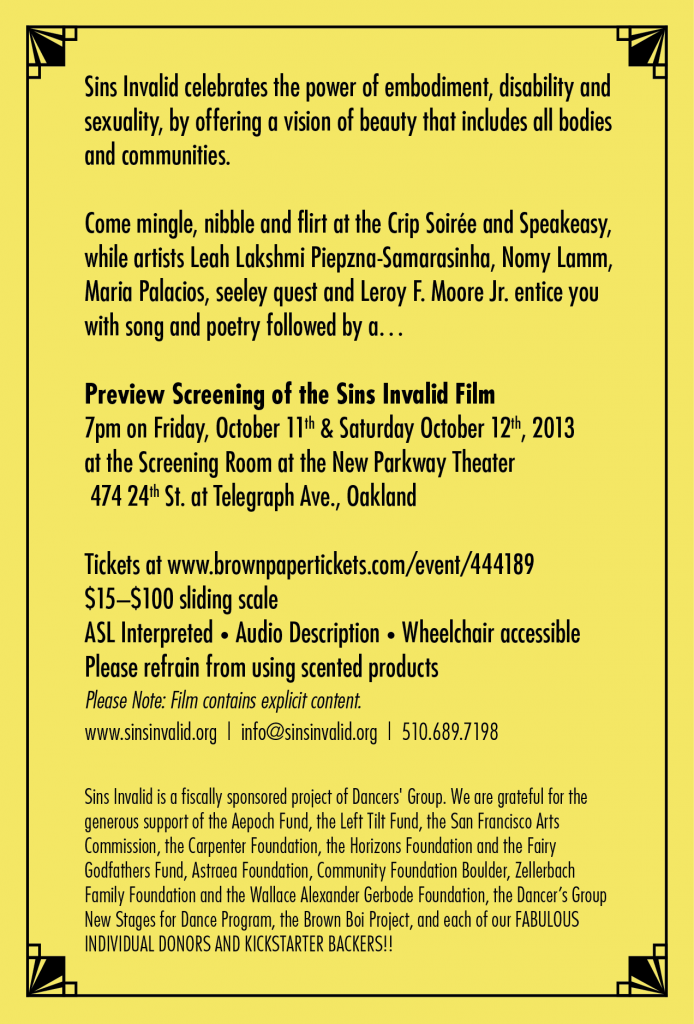 [Against a yellow background bordered by black lines with diamond designs at each corner, the text reads: "Sins Invalid celebrates the power of embodiment, disability and sexuality, by offering a vision of beauty that includes all bodies and communities.
[Against a yellow background bordered by black lines with diamond designs at each corner, the text reads: "Sins Invalid celebrates the power of embodiment, disability and sexuality, by offering a vision of beauty that includes all bodies and communities.
Come mingle, nibble and flirt at the Crip Soiree and Speakeasy, while artists Leah Lakshmi Piepzna-Samarasinha, Nomy Lamm, Maria Palacios, seeley quest and Leroy F. Moore, Jr. entice you with song and poetry following by a...
Preview screening of the Sins Invalid Film
7 pm on Friday, October 11th and Saturday, October 12th, 2013
at the Screening Room at the New Parkway Theater, 474 24th St. at Telegraph Ave., Oakland
Tickets at www.brownpapertickets.com/event/444189, $15-$100 sliding scale
ASL interpreted – Audio Description – Wheelchair accessible
Please refrain from using scented products
Please note: Film contains explicit content.
www.sinsinvalid.org | info@sinsinvalid.org | 510.689.7198
Sins Invalid is a fiscally sponsored project of Dancers' Group. We are grateful for the generous support of the Aepoch Fund, the Left Tilt Fund, the San Francisco Arts Commission, the Carpenter Foundation, the Horizons Foundation and the Fairy Godfathers Fun, Astraea Foundation, Community Foundation Boulder, Zellerbach Family Foundation and the Wallace Alexander Gerbode Foundation, the Dancer's Group New Stages for Dance Program, the Brown Boi Project, and each of our FABULOUS INDIVIDUAL DONORS AND KICKSTARTER BACKERS!!”]
© 2013 by Rachel Cohen-Rottenberg
A Word about Disability Terminology
As commenters on this blog, you are welcome to use whatever disability terminology you wish: disabled person, person with disabilities, differently abled, special needs, and so on. I prefer identity-first language (disabled person), but terminology is a matter of personal choice, and I follow a policy of non-interference in other people’s choices.
I don’t mind discussions about the relative merits of different terminologies, but they have to be in the proper context. On this blog, the proper context would be a post that focuses on terminology issues. In that context, everyone is welcome to weigh in. In any other context, I would consider raising the issue a derailment from the focus of the discussion.
No matter what the context, no one is welcome to advise, cajole, or pressure anyone else to use a different kind of terminology, and no one is welcome to tell people they’re doing it wrong. Please respect the ways in which other people wish to be addressed. So, for example, it’s out of line to respond to I’d prefer to be called a disabled person with You’ll always be a person first to me!
Seriously. Don’t do that.
Further, if a person has made a very clear request to be called by one term, and someone else insists on using another term to address that particular person, it is fine for the first person to restate the preference and ask that the other person abide by it.
The reason for all of this is simple: We are all fighting a hard battle. If the terminology that people have chosen helps them to move through the world feeling empowered and beautiful, I want people to feel that their choices are supported.
Not every use of a particular term needs to be an occasion for weighing in on your feelings about it. Please show respect for the choices of others, even if you disagree with them.
Thank you.
© 2013 by Rachel Cohen-Rottenberg
Smoochie Paraplegic Cat: When Disability Tropes Take on a Life of Their Own
On Love Meow: A Blog for Ultimate Cat Lovers, there is an article with the following title:
Smoochie Paraplegic Cat Doesn’t Let Her Disability Define Her
I kid you not. That’s a real headline. And it’s not on a parody site. (I checked.) Love Meow is just a site with lots of cute pictures and videos of cats.
I love cats. I love pictures and videos of cats. I have even been known to share them on Facebook with appropriate expressions of squeeee! and OMG THIS IS SO CUTE. And Smoochie is freakin’ adorable. Oh dear God. That face! I love her wheels. I love that her owners cared enough to get her some wheels. And I love that she has a happy life.
Now that we’ve established that I’m not some cat-hating curmudgeon bent on ruining everyone’s fun little cat-fest, let’s get to the disability rhetoric, because it’s just out of control. Along with the title, the first paragraph is almost enough for a bingo card:
Smoochie the cat doesn’t let her disability stop her. Being paraplegic, she doesn’t want anyone to pity her. With love and a pair of wheels, Smoochie now lives a happy life that inspires many.
So let’s see: so far, we have the person-first (cat-first?) trope (“doesn’t let her disability define her”), the overcoming trope (“doesn’t let her disability stop her”), the pity trope (couched as a plea to not pity little Smoochie), and the inspiration trope (“lives a happy life that inspires many”).
Already, I’m confused. First of all, I didn’t realize that cats struggle with identity issues. I mean, do cats argue about whether disability “defines” them? I think not. I’m also not sure that cats know that disability is supposed to stop them, being as they’re not all caught up in the discourse that passes for reality amongst human beings. I’m also not sure that cats know what pity is.
Yes, yes, I know that people project things onto animals all the time. But this is really over the top. It’s like someone took all the disability tropes in the world and plastered them on cute little Smoochie. These tropes are repeated throughout the article:
Cats with disabilities are no different from cats without disabilities: “The pure joy she shows when they put her in the wheelchair is as if she never had the disability. She runs around and plays just like any other kitties.”
See the cat, not the disability: “Smoochie never lets her disability define her.”
Cats with disabilities, and their heroic rescuers, should have their own Inspiring After-School Special: “Her humans believed in her and gave her a second chance at life, and now she’s happy and healthy as the mascot at West Side Cats, inspiring many with her story.”
Supercrip cats know how to get it done: “Smoochie is paraplegic but she doesn’t let it stop her.”
Disabled cats are inspirational: “Smoochie is now the mascot at West Side Cats, inspiring many with her story.”
It’s fascinating the ways in which these tropes amble around the culture, attaching themselves to any creature that is disabled. If anyone doubts that disability is a social construct, I give you Exhibit A: The Case of Smoochie the Cat.
Read it and weep.
© 2013 by Rachel Cohen-Rottenberg
Disabled People As A Test of Character: The Guinness Commercial
Okay, so. Guinness has a rather, shall we say, problematic new ad that features a bunch of guys in wheelchairs playing basketball. And when I say problematic, I mean that it makes me want to mutter expletives under my breath. Watch, listen, and be appalled:
The ad begins with a basketball flying in slow motion above a basket. Repetitive piano music plays – the kind that creates the score for “inspirational” stories of all kinds. The next several seconds of the video show six guys in wheelchairs playing basketball. You see them rolling down the court. Some of them crash into each other, fall over, and get back up. One guy scores a basket and high-fives another guy. Another guy scores a basket. Then, one of the players stands up and say, “You guys are getting better at this! Yeah! Next week, buddy!” Then, all but one of them stand up out of their wheelchairs and head for the exit, with the person in a wheelchair going with them.
The voiceover says, “Dedication. Loyalty. Friendship. The choices we make reveal the true nature of our character.”
The ad ends with all of the guys having a Guinness in a bar. The Guiness ad reads “Guinness. Made of More.”
When I first saw this ad, I thought it was just going to be an inspiration-porn kind of thing, with a good serving of “Look at what tough men they are! And they love Guinness! Tough men love Guinness! Even if they’re in wheelchairs! Roar!” Bad enough, but not surprising.
But then one of the guys gets up out of his wheelchair. And I’m all WTF?
And then four more guys get up out of their wheelchairs. And I’m even more all WTF?
So let’s see what we’re supposed to make of this video:
1) Real friends buy expensive lightweight wheelchairs so that they can play basketball with their disabled friends. Is this even a possibility for most people? No. No, it’s not.
2) Real friends (or is it just real men?) can somehow learn how to use a manual wheelchair well enough to play basketball in it. Is this even a possibility for most people? No. No, it’s not.
3) The one disabled person must be called out as an object of charity with “Next week, buddy!” Under no circumstances is anyone to say, “Next week, everyone!” Because, apparently, the other five guys just showed up for the disabled guy’s sake, not because they all wanted to play basketball together. Awesome.
4) Disabled people must be called “buddy.” Apparently, this is affectionate. If you’re five.
5) Including a disabled person become an opportunity to show what fine, noble, humanitarian people we are.
What can I say? If “the choices we make reveal the true nature of our character,” and we choose to make a disabled person the occasion for humanitarian sentiments by calling him out as an object of charity with a diminutive generally reserved for children — well, that makes our choices very suspect indeed, doesn’t it?
Look. The strange and surreal nature of the whole commercial aside, its message is about inclusion, and that would be great, except that the message is being handled in all of the wrong ways. Not only is the charity model so very, very outdated, but the whole idea of putting people on a pedestal for being inclusive is tiresome.
Including people is the right thing to do. Period. It’s not a test of character. It’s not an opportunity for humanity and heroism. It’s just basic ethics. Very basic. Very ordinary. Very pedestrian. No big deal. No need to put it on a billboard. No need to construct a commercial around it.
Inclusion is just another word for basic human rights.
Violating basic human rights? That shows something about your character.
Supporting basic human rights? That’s just something you’re supposed to do.
© 2013 by Rachel Cohen-Rottenberg
What It Means To Be A Help Object
I’ve been having a conversation with my friend Julie Rose. Julie has just been diagnosed with Lupus and has become visibly disabled. In response to my piece about disabled people as help objects, she wrote to me and said that she really couldn’t wrap her mind around what being a help object meant until she began to navigate the world with a visible disability. Now she understands it excruciatingly well.
What Julie has to say is so right and so clear that, with her permission, I am sharing it here. She writes:
Before the last few days, I was confused by the term “help object.” It took me less than 48 hours of being a “public cripple” to know what it means.
So far:
1. It means that if you offer me help and I don’t accept it, I’m an ungrateful, ungracious asshole. It doesn’t matter if what you are offering me is useful or not. It doesn’t even matter if what you are offering might be life threatening to me. I must say, “thank you” and accept it with total aplomb.
2. I can’t have a sense of humor. If I do, you will be confused and think I’m fine and feel duped by my asking for help. Therefore, I’m a scam artist, not a cripple.
3. Since I’m home bound, I must have nothing to do and no schedule, so you can barge in on me any time and you can also not show up or call when you have made a commitment to do so. After all, I’ll always be here, in bed, while you are busy with whatever a real life has to offer. I shouldn’t complain. Again, I’d be a whiner or an ungrateful asshole or both.
4. If you don’t follow through with what you promised you’d do, I must still be gracious and say “thank you.” I can’t say it put me out because in your eyes I have no life.
I don’t think I’ve read anything that has made the privilege of Ability quite so clear to me. This level of privilege is stunning. Privilege, in and of itself, isn’t something that one can escape, but it’s something that one can use well or badly. In the kinds of situations that Julie talks about, it’s being used badly.
To use it badly means to treat ill or disabled people as though we belong in some whole other category in which the rules of basic decency do not apply.
Do want to give help? Then ask what help is needed. Do you want to visit? Then ask what a good time might be and show up. Are you wondering how someone can have a sense of humor and be ill at the same time? Stop wondering and start believing.
I fundamentally do not understand why these are such difficult concepts. Do people suddenly lose their rights to be treated like human beings because our bodies change? No. We don’t. Why is this truth so hard to grasp?
© 2013 by Rachel Cohen-Rottenberg

